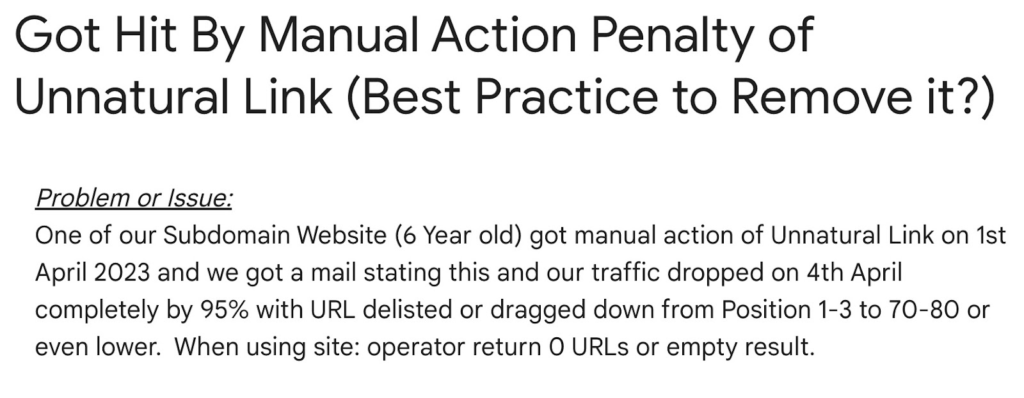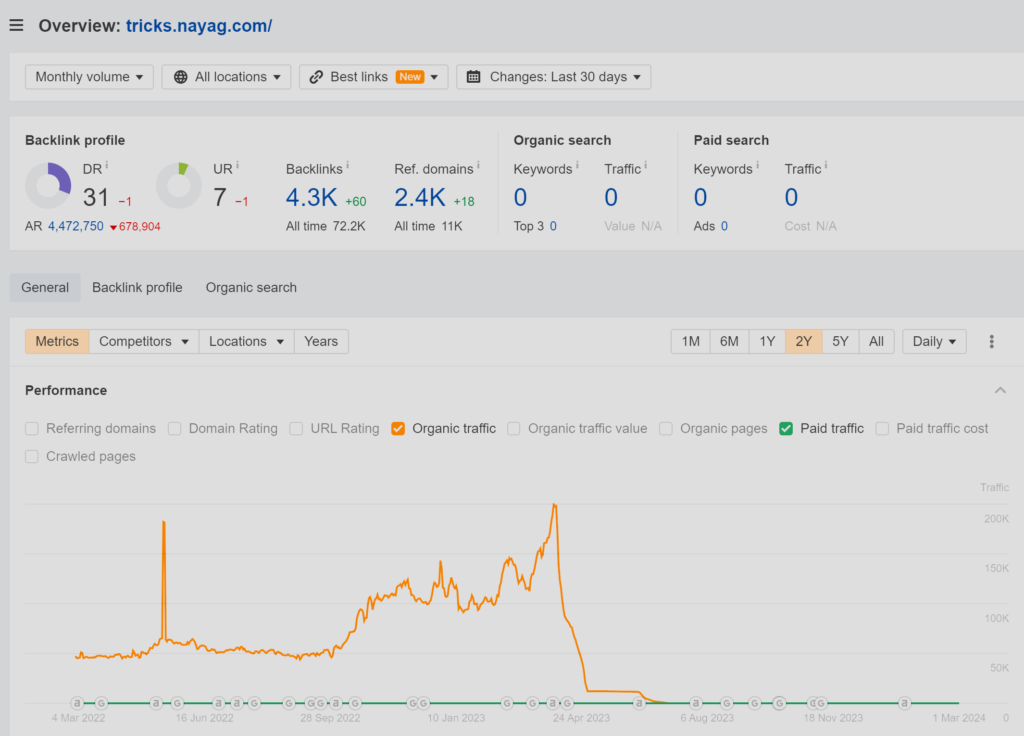Google’s algorithm is designed to determine which websites have the most helpful content with the most organic linking structure both in terms of backlinks and internal links.
Backlinks are a very important component of any successful SEO campaign with SearchLogistics stating that Google has an average of 3.8x more backlinks on page 1 versus page 2-10 results.
So Google is not happy with webmasters when an SEO or PR Specialist builds unnatural links from a website to manoeuvre the algorithm to go ahead of websites that are working legit.
In this ultimate guide on unnatural links, I’ll be walking you through what they are all about, different variations that link builders utilize to build these black hat links and why Google hates websites with such links pointing towards them.
In the end, I’ll round up the potential consequences websites have to face that deploy unnatural backlinks and how to potentially recover from such Google Penalties.
To begin with, what is the worst that can happen if you have unnatural links pointing towards your website?
The worst thing that can happen to a website owner or SEO Manager is to wake up one fine day and see their website has lost almost all of their traffic.
This is a worst-case scenario that happened to a website (tricks.nayag.com) on the 1st of April, 2023.
The website at that time was getting more than 198,000 monthly organic visitors and the Google penalty hit them hard.

I went through this subdomain performance for the same period on Ahrefs and found that after the Google Penalty for the Unnatural Links the traffic went from 198K to 0K.

When we went through the backlinks data for this website we saw that the website had 9535 links pointing towards them with over 6,948 links from DR 0-20 websites and over 5,509 backlinks from 0 DR websites.
Now you know the potential Google Penalty for Unnatural Links let’s deep dive into what they are all about
Google officially recognized unnatural backlinks in the 2012 Penguin update.
The algorithm update was meant to cater for low-quality backlinks, over-optimized anchor texts and keyword stuffing.
But the thing is why did Google make unnatural links a part it’s algorithm in 2012 and since then subsequent updates have continued to hone in on improving Google user experience by investigating link profile of websites.
The answer is Google interprets such link schemes as an attempt to artificially manipulate a websites ranking.
These links are not organically earned as in cases where the webmaster cites your webpage as a reference for one of there stories, pages or any related content. Examples of unnatural backlinks includes paid insertions where you pay another webmaster to obtain a do-follow backlink.
Then the question arises with such a high probability of a penalty why do webmasters and SEOs attempt to earn such links?
The most prevalent reason for this is SEOs have link targets to achieve and unnatural links do on occasions provide a short term boost to websites.
Now that you understand the negatives of unnatural link building you need to be able to assess unnatural links.
Important Steps to Find Unnatural Links?
Step 1: You will need a tool like Ahrefs or SEMRush
Step 2: Check the number of links from a referring domains in Ahrefs
It will be a negative signal to Google if it detects that your website dozens of links pointing to your website from the same referring domain.
In the example below you can see the website has multiple websites with more then 500 links to target.
This is a pure example of a website where unnatural linking is taking place.

Too many links from low authority DR Websites
Domain Reputation is a sign of a websites backlinks profile strength.
Generally websites with a higher Domain Reputation number are considered from trust worthy.
Domain Reputation as calculated by Ahrefs is between a scale of 0-100.
When a website builds backlinks from other members of the online fraternity where the links are from sites with a very low Domain Reputation and with irrelevant anchor text it gives Google the chance to detect links that are low quality.
You as an SEO or Webmaster need to ensure that you only earn links from websites that have a Domain Reputation higher then you, the anchor text is not keyword stuffed rather contexualized & finally the website pointing towards your content is topically relevant.
Low DR Websites can be detected by going to the Backlinks Profile of any website and assessing through the DR filter how whether a link is worthy or not.
The following example showcases a website with low link authority because of low DR Websites linking towards them.

Some examples of Unnatural Links to help you steer well away to safety
Blog Comments
User-generated spam, such as unsolicited and irrelevant blog comments or forum posts linking back to a website, can negatively impact the site’s search engine ranking. This content often falls under the category of “unnatural links,” which search engines like Google identify as manipulative tactics intended to boost a website’s search engine results page (SERP) positioning artificially.
Spam Listings
Spam listings are fake or misleading business profiles set up on various online directories, social media platforms, and local business listings. When these listings include links pointing back to a particular website, they contribute to that site’s backlink profile. If the primary purpose of these listings is to manipulate search engine algorithms by inflating the number of backlinks artificially, they are considered part of an unnatural backlinking strategy. This practice is against the guidelines of most search engines, including Google, which seeks to ensure that rankings are a fair and accurate reflection of a site’s relevance and quality.
Low Quality Directories
Avoid using nondescript online business directories that promise to boost your search rankings, as they often contain low-quality, hidden links filled with excessive keywords that search engines might interpret as spam.
Directories of poor quality typically exhibit one or more of the following traits:
- They approve submissions indiscriminately without any review process.
- Their design is not user-friendly, making navigation frustrating.
- They lack security measures (using HTTP instead of HTTPS).
Refrain from allowing such directories to feature your business. Instead, focus on establishing your presence in reputable directories like Google Business Profile, Reddit, and Yelp.
Moreover, aim to create backlinks for your site on websites relevant to your industry. For example, a burger joint could benefit from being listed on Toasttab or Chownow, platforms that enables customers to discover your business, enhancing your visibility and customer access.
Poor Quality PBNs
Websites referred to as private blog networks (PBNs) provide backlinks for a fee, aiming to boost your site’s position in search results. This approach may appear to give a quick lift to your SEO efforts, yet any positive outcome is typically temporary.
What’s the reason behind this?
Google has developed algorithms capable of identifying such deceptive strategies. Engaging with PBNs, therefore, risks attracting penalties from Google or could even result in your site being completely removed from its search index.
Performing a search for “PBN links for sale” will display a multitude of these services available online.

Take Action NOW to Avoid a Google Penalty for Unnatural Backlinks

For those utilizing Google Analytics, access to Google’s Search Console is a given, offering valuable insights into your site’s link structure. To initiate a link audit, navigate to the Search Console’s Link Report page. Here, by clicking “Export External Links” and selecting “More Sample Links,” you can download your link data in the format of your choice.
For a more thorough examination, the Semrush Backlink Audit Tool helps pinpoint which links to disavow. Crafting a disavow file (.txt) involves a straightforward format: each entry on a new line, starting with “domain:”, and the filename itself doesn’t matter. This method allows for domain-wide disavowal, sparing the effort of specifying individual URLs, which is rarely necessary.
Upload this file via the Google Disavow Tool, navigating through the warnings until you can submit your file. Google will then disregard these domains in your site’s ranking assessment within a day.
In summary, identifying unwanted links, compiling a disavow list, and uploading it to Google’s Disavow Tool are the key steps to cleansing your site’s backlink profile.












